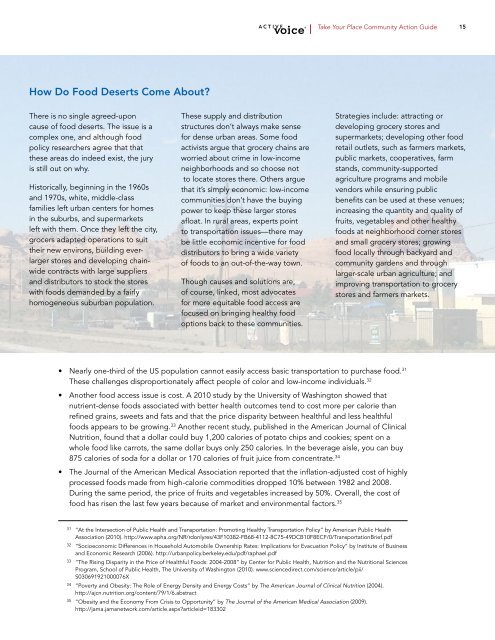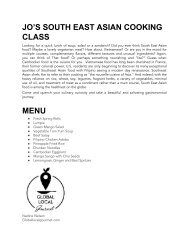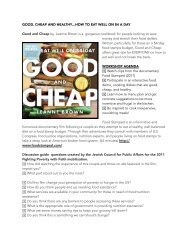APATT_CommunityActionGuide
Create successful ePaper yourself
Turn your PDF publications into a flip-book with our unique Google optimized e-Paper software.
Take Your Place Community Action Guide<br />
15<br />
How Do Food Deserts Come About?<br />
There is no single agreed-upon<br />
cause of food deserts. The issue is a<br />
complex one, and although food<br />
policy researchers agree that that<br />
these areas do indeed exist, the jury<br />
is still out on why.<br />
Historically, beginning in the 1960s<br />
and 1970s, white, middle-class<br />
families left urban centers for homes<br />
in the suburbs, and supermarkets<br />
left with them. Once they left the city,<br />
grocers adapted operations to suit<br />
their new environs, building everlarger<br />
stores and developing chainwide<br />
contracts with large suppliers<br />
and distributors to stock the stores<br />
with foods demanded by a fairly<br />
homogeneous suburban population.<br />
These supply and distribution<br />
structures don’t always make sense<br />
for dense urban areas. Some food<br />
activists argue that grocery chains are<br />
worried about crime in low-income<br />
neighborhoods and so choose not<br />
to locate stores there. Others argue<br />
that it’s simply economic: low-income<br />
communities don’t have the buying<br />
power to keep these larger stores<br />
afloat. In rural areas, experts point<br />
to transportation issues—there may<br />
be little economic incentive for food<br />
distributors to bring a wide variety<br />
of foods to an out-of-the-way town.<br />
Though causes and solutions are,<br />
of course, linked, most advocates<br />
for more equitable food access are<br />
focused on bringing healthy food<br />
options back to these communities.<br />
Strategies include: attracting or<br />
developing grocery stores and<br />
supermarkets; developing other food<br />
retail outlets, such as farmers markets,<br />
public markets, cooperatives, farm<br />
stands, community-supported<br />
agriculture programs and mobile<br />
vendors while ensuring public<br />
benefits can be used at these venues;<br />
increasing the quantity and quality of<br />
fruits, vegetables and other healthy<br />
foods at neighborhood corner stores<br />
and small grocery stores; growing<br />
food locally through backyard and<br />
community gardens and through<br />
larger-scale urban agriculture; and<br />
improving transportation to grocery<br />
stores and farmers markets.<br />
• Nearly one-third of the US population cannot easily access basic transportation to purchase food. 31<br />
These challenges disproportionately affect people of color and low-income individuals. 32<br />
• Another food access issue is cost. A 2010 study by the University of Washington showed that<br />
nutrient-dense foods associated with better health outcomes tend to cost more per calorie than<br />
refined grains, sweets and fats and that the price disparity between healthful and less healthful<br />
foods appears to be growing. 33 Another recent study, published in the American Journal of Clinical<br />
Nutrition, found that a dollar could buy 1,200 calories of potato chips and cookies; spent on a<br />
whole food like carrots, the same dollar buys only 250 calories. In the beverage aisle, you can buy<br />
875 calories of soda for a dollar or 170 calories of fruit juice from concentrate. 34<br />
• The Journal of the American Medical Association reported that the inflation-adjusted cost of highly<br />
processed foods made from high-calorie commodities dropped 10% between 1982 and 2008.<br />
During the same period, the price of fruits and vegetables increased by 50%. Overall, the cost of<br />
food has risen the last few years because of market and environmental factors. 35<br />
31 “At the Intersection of Public Health and Transportation: Promoting Healthy Transportation Policy” by American Public Health<br />
Association (2010). http://www.apha.org/NR/rdonlyres/43F10382-FB68-4112-8C75-49DCB10F8ECF/0/TransportationBrief.pdf<br />
32 “Socioeconomic Differences in Household Automobile Ownership Rates: Implications for Evacuation Policy” by Institute of Business<br />
and Economic Research (2006). http://urbanpolicy.berkeley.edu/pdf/raphael.pdf<br />
33 “The Rising Disparity in the Price of Healthful Foods: 2004-2008” by Center for Public Health, Nutrition and the Nutritional Sciences<br />
Program, School of Public Health, The University of Washington (2010). www.sciencedirect.com/science/article/pii/<br />
S030691921000076X<br />
34 “Poverty and Obesity: The Role of Energy Density and Energy Costs” by The American Journal of Clinical Nutrition (2004).<br />
http://ajcn.nutrition.org/content/79/1/6.abstract<br />
35 “Obesity and the Economy From Crisis to Opportunity” by The Journal of the American Medical Association (2009).<br />
http://jama.jamanetwork.com/article.aspx?articleid=183302

















